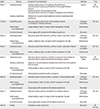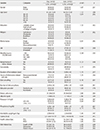Abstract
Purpose
The purpose of this study was to examine effects of a dietary program based on self-efficacy theory on dietary adherence, physical status and quality of life (QoL) in hemodialysis patients.
Methods
A non-equivalent control group pre-post test design was used. The intervention group received the dietary program for 8 weeks from August 4 to September 26, 2014. The control group received only usual care.
Results
ANCOVA showed that dietary adherence (F=64.75, p<.001) was significantly different between the two groups. Serum albumin (F=12.13, p =.001), interdialytic weight gain (F=56.97, p<.001), calories (F=15.80, p<.001) as physical status indices were significantly different, but serum potassium (F=2.69, p=.106) and serum phosphorus (F=1.08, p=.303) showed no significant difference between the two groups. In terms of health-related QoL, the physical component scale (F=10.05, p=.002) and the mental component scale (F=16.66, p<.001) were significantly different between the two groups. In addition, in terms of diet related QoL, diet level (F=35.33, p<.001) and satisfaction level (F=15.57, p<.001) were significantly different between the two groups, but dietary impact level (F=1.23, p =.271) was not significantly different.
Figures and Tables
Notes
References
1. Lim CS. Medical therapy in patients with chronic kidney disease. J Korean Med Assoc. 2012; 55(4):381–389. DOI: 10.5124/jkma.2012.55.4.381.
2. ESRD Registry Committee, Korean Society of Nephrology. Current renal replacement therapy in Korea: Insan memorial dialysis registry, 2014[Internet]. Seoul: Korean Society of Nephrology;cited 2016 January 1. Available from: http://www.ksn.or.kr/journal/2015/index.html.
3. Fouque D, Kalantar-Zadeh K, Kopple J, Cano N, Chauveau P, Cuppari L, et al. A proposed nomenclature and diagnostic criteria for protein-energy wasting in acute and chronic kidney disease. Kidney Int. 2008; 73(4):391–398. DOI: 10.1038/sj.ki.5002585.
4. Cano NJ, Miolane-Debouit M, Léger J, Heng AE. Assessment of body protein: Energy status in chronic kidney disease. Semin Nephrol. 2009; 29(1):59–66. DOI: 10.1016/j.semnephrol.2008.10.008.
5. Lee J, Kim JM, Kim Y. Association of diet-related quality of life with dietary regimen practice, health-related quality of life, and gastrointestinal symptoms in end-stage renal disease patients with hemodialysis. Korean J Nutr. 2013; 46(2):137–146. DOI: 10.4163/kjn.2013.46.2.137.
6. Noori N, Kalantar-Zadeh K, Kovesdy CP, Bross R, Benner D, Kopple JD. Association of dietary phosphorus intake and phosphorus to protein ratio with mortality in hemodialysis patients. Clin J Am Soc Nephrol. 2010; 5(4):683–692. DOI: 10.2215/cjn.08601209.
7. Wells JR. Hemodialysis knowledge and medical adherence in African Americans diagnosed with end stage renal disease: Results of an educational intervention. Nephrol Nurs J. 2011; 38(2):155–162.
8. Zrinyi M, Juhasz M, Balla J, Katona E, Ben T, Kakuk G, et al. Dietary self-efficacy: Determinant of compliance behaviours and biochemical outcomes in haemodialysis patients. Nephrol Dial Transplant. 2003; 18(9):1869–1873.
9. Hwang YH, Yi M. Evaluation of an individualized education before discharge and follow-up telephone consultation on self-efficacy for kidney transplant patients. J Korean Biol Nurs Sci. 2015; 17(4):331–340. DOI: 10.7586/jkbns.2015.17.4.331.
10. Moattari M, Ebrahimi M, Sharifi N, Rouzbeh J. The effect of empowerment on the self-efficacy, quality of life and clinical and laboratory indicators of patients treated with hemodialysis: A randomized controlled trial. Health Qual Life Outcomes. 2012; 10:115. DOI: 10.1186/1477-7525-10-115.
11. Seo AR, Park KS, Kim BK, Kim YL, Choi JY. A validation of dietary self-efficacy questionnaire in hemodialysis patients. Korean J Health Promot. 2012; 12(1):22–30.
12. Kim MJ, Park CN, Kang YE, Lee SS. The effects of nutrition education and regular exercise on nutritional status, quality of life and fatigue in hemodialysis patients. J Korean Diet Assoc. 2013; 19(4):373–388.
13. Bandura A. Social foundations of thought and action: A social cognitive theory. Englewood Cliffs, NJ: Prentice-Hall;1986.
14. Song MS. Effects of empowerment program on the hemodialysis patients[dissertation]. Busan: Kosin University;2004. 1–112.
15. Pasyar N, Rambod M, Sharif F, Rafii F, Pourali-Mohammadi N. Improving adherence and biomedical markers in hemodialysis patients: The effects of relaxation therapy. Complement Ther Med. 2015; 23(1):38–45. DOI: 10.1016/j.ctim.2014.10.011.
16. García-Llana H, Remor E, Selgas R. Adherence to treatment, emotional state and quality of life in patients with end-stage renal disease undergoing dialysis. Psicothema. 2013; 25(1):79–86. DOI: 10.7334/psicothema2012.96.
17. Lee JK, Yang YH. The effects of programs using strategies for promoting self efficacy in patients with lung cancer. J Korean Acad Adult Nurs. 2006; 18(4):642–652.
18. Tinti F, Umbro I, Giannelli V, Merli M, Corradini SG, Rossi M, et al. Acute renal failure in liver transplant recipients: Role of pretransplantation renal function and 1-year follow-up. Transplant Proc. 2011; 43(4):1136–1138. DOI: 10.1016/j.transproceed.2011.02.042.
19. Blackburn SL. Dietary compliance of chronic hemodialysis patients. J Am Diet Assoc. 1977; 70(1):31–37.
20. Kim HS, Lee KB, Lee YS, Kim H, Seh BS, Lim SW, et al. The reliability and the validity of health related QOL measurement method in hemodialysis patients. Korean J Nephrol. 2008; 27(1):78–84.
21. Ware JE, Kosinski M, Bjorner JB, Turner-Bowker D, Gandek B. SF-36v2 health survey: Administration guide for clinical trial investigators. Lincoln, RI: QualityMetric, Inc;2008.
22. Delahanty LM, Hayden D, Ammerman A, Nathan DM. Medical nutrition therapy for hypercholesterolemia positively affects patient satisfaction and quality of life outcomes. Ann Behav Med. 2002; 24(4):269–278.
23. Yoo MJ. The effects of a video program for hemodialysis patients on self care, stress, and physiological indexes[master's thesis]. Gwangju: Chonnam National University;2014. 1–40.
24. Park MH. Effects of a self-efficacy promoting program on the selfcare behaviors and physio- psychological function in patients with continuous ambulatory peritoneal dialysis[dissertation]. Gwangju: Chonnam National University;2004. 1–104.
25. Jang YH, Oh HS, Jang GS. Self-care behaviors and physiological index according to cognitive function of hemodialysis patients. Korean J Health Serv Manag. 2012; 6(2):57–69. DOI: 10.12811/kshsm.2012.6.2.057.
26. Ko HK, Park GJ. Effects of self-efficacy promotion program on self-efficacy, self-care behavior, and quality of life in breast cancer patients receiving radiotherapy. J Korean Oncol Nurs. 2011; 11(2):136–146. DOI: 10.5388/jkon.2011.11.2.136.
27. Park HM, Lee HS. Effects of empowerment education program for hemodialysis patients on self-efficacy, self-care agency, self-care activities and physiologic parameters. Korean J Rehabil Nurs. 2010; 13(2):151–160.
28. Kim JE, Hwang EA, Kwak JH, Jin KB, Yoon JS, Han SY, et al. Change of parathyroid hormone and markers of bone metabolism after renal transplantation. Korean J Nephrol. 2007; 26(5):601–609.
29. Shim OS. The study on the elderly homodialysis patients' transition of health condition and health-related quality of life. J Korean Gerontol Soc. 2010; 30(1):179–194.
30. Ryu EJ, Lee JM, Choi SY. The relationships of pain cognition, performance status, and hope with health-related quality of life in cancer patients. J Korean Acad Adult Nurs. 2007; 19(1):155–165.
31. Kim Y, Hwang JS, Ahn J, Lee SM, Lee YJ, Shin S. Utilities for prostate cancer by cancer stage and treatment step in Korea. Korean J Health Econ Policy. 2013; 19(2):1–20.




 PDF
PDF ePub
ePub Citation
Citation Print
Print







 XML Download
XML Download